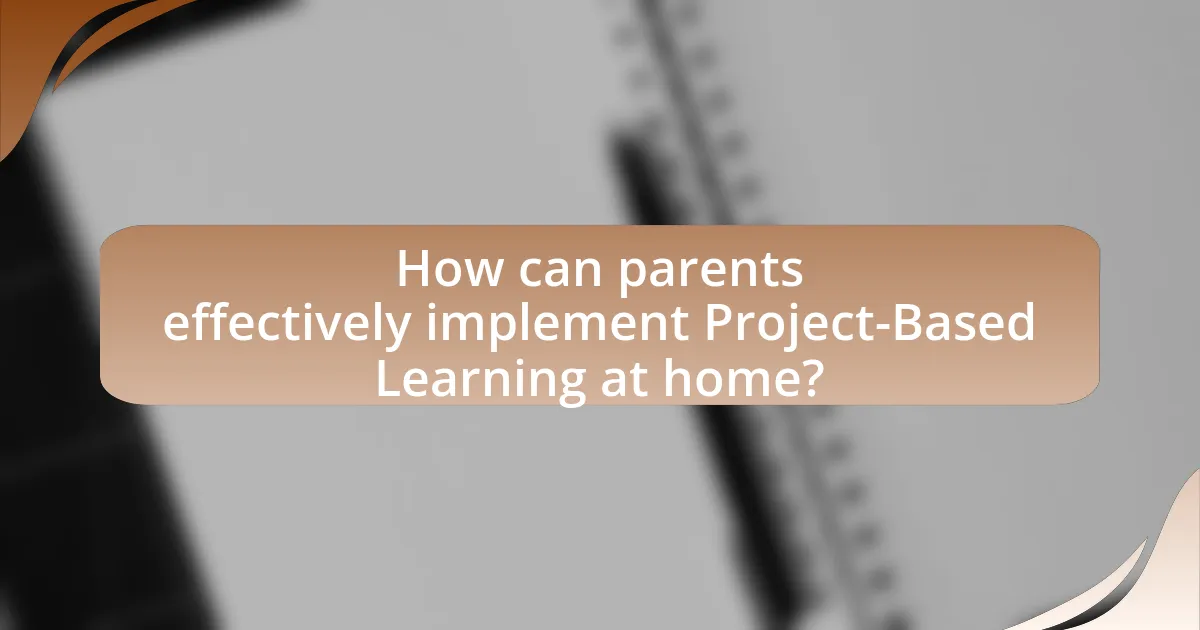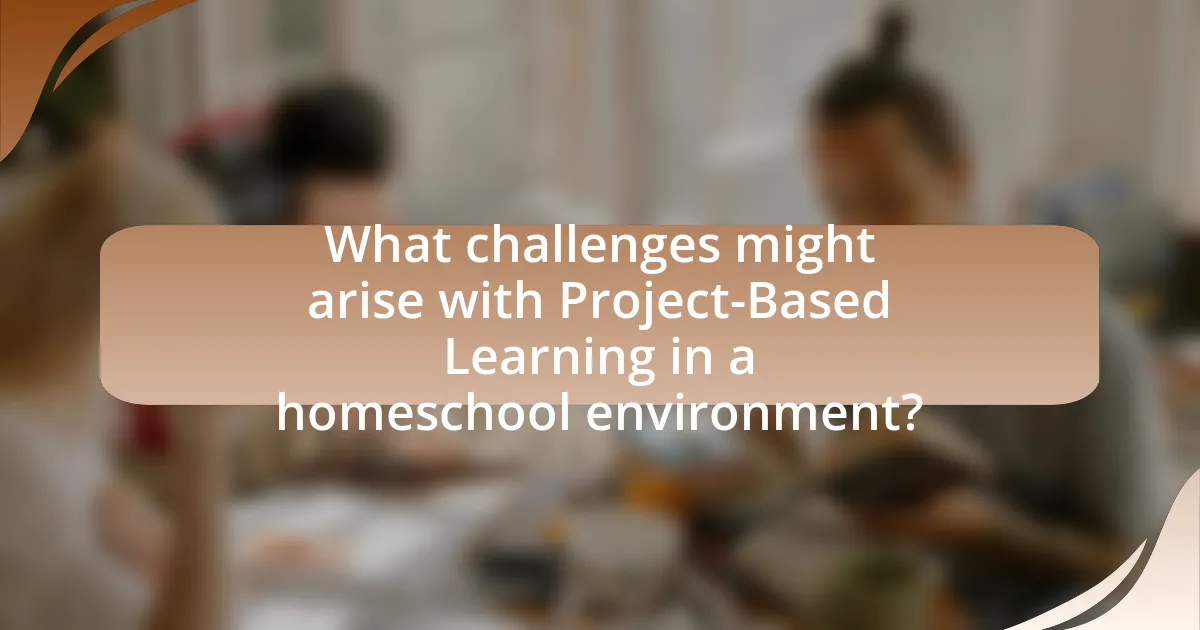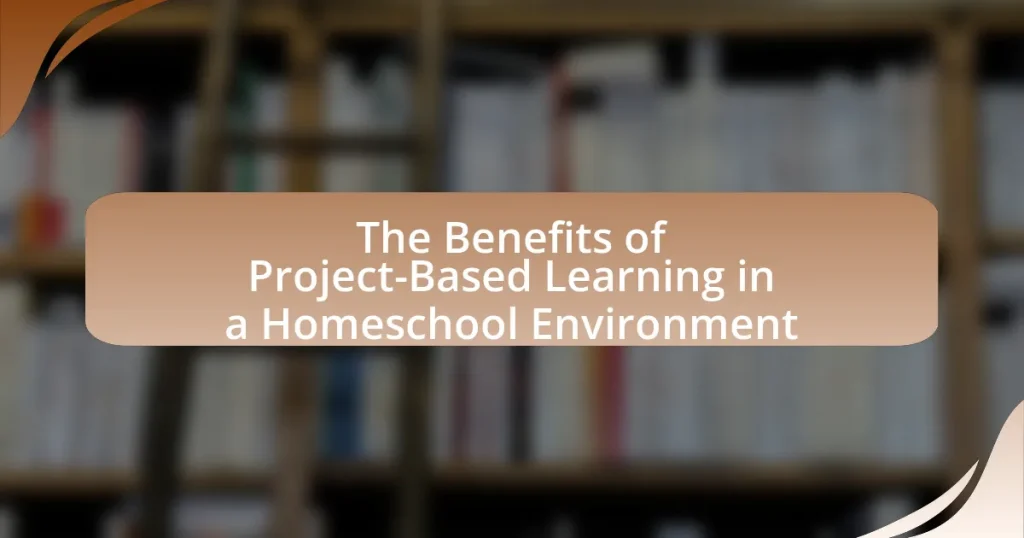Project-Based Learning (PBL) in a homeschool environment is an educational approach that emphasizes hands-on projects, critical thinking, problem-solving, and collaboration. This method enhances student engagement and motivation by connecting learning to real-world applications, leading to improved academic performance and essential skill development. Key characteristics of PBL include student-driven inquiry, real-world relevance, and collaborative work, which are particularly effective in a homeschooling context where personalized learning can thrive. The article explores the core principles of PBL, the benefits it provides in a homeschool setting, and practical strategies for parents to implement and assess PBL effectively, while also addressing potential challenges and resource limitations.

What is Project-Based Learning in a Homeschool Environment?
Project-Based Learning (PBL) in a homeschool environment is an educational approach where students engage in hands-on projects that require critical thinking, problem-solving, and collaboration. This method allows learners to explore real-world issues and challenges, fostering deeper understanding and retention of knowledge. Research indicates that PBL enhances student motivation and engagement, as it connects learning to practical applications, making education more relevant and meaningful. Studies, such as those conducted by the Buck Institute for Education, show that students involved in PBL demonstrate improved academic performance and develop essential skills for future success.
How does Project-Based Learning differ from traditional learning methods?
Project-Based Learning (PBL) differs from traditional learning methods by emphasizing hands-on, real-world projects as the primary mode of instruction, rather than relying on rote memorization and passive learning. In PBL, students engage in complex tasks that require critical thinking, collaboration, and problem-solving, which fosters deeper understanding and retention of knowledge. Research indicates that students in PBL environments often demonstrate higher levels of engagement and achievement compared to those in traditional settings, as evidenced by a study published in the “Journal of Educational Psychology” by Thomas Markham, which found that PBL enhances student motivation and learning outcomes.
What are the key characteristics of Project-Based Learning?
Project-Based Learning (PBL) is characterized by its emphasis on student-driven inquiry, real-world relevance, collaboration, and the development of critical thinking skills. In PBL, students engage in projects that require them to explore complex questions or challenges, fostering deeper understanding and retention of knowledge. Research indicates that PBL enhances student engagement and motivation, as it connects learning to real-life contexts, allowing learners to apply their skills in meaningful ways. Additionally, PBL promotes teamwork and communication, as students often work in groups, sharing ideas and responsibilities, which mirrors professional environments.
How does the homeschooling context influence Project-Based Learning?
The homeschooling context significantly enhances Project-Based Learning (PBL) by allowing for personalized learning experiences tailored to individual student interests and needs. In a homeschooling environment, parents can design projects that align closely with their child’s passions, fostering deeper engagement and motivation. Research indicates that personalized learning approaches, such as those found in homeschooling, lead to improved academic outcomes and higher levels of student satisfaction. For instance, a study by the National Center for Education Statistics found that homeschooled students often outperform their peers in traditional settings on standardized tests, highlighting the effectiveness of customized educational strategies like PBL in a homeschooling context.
What are the core principles of Project-Based Learning?
The core principles of Project-Based Learning (PBL) include student-centered learning, real-world relevance, collaborative work, and reflective practice. Student-centered learning emphasizes active engagement, allowing learners to take ownership of their educational journey. Real-world relevance connects projects to authentic issues, enhancing motivation and applicability. Collaborative work fosters teamwork and communication skills, essential for success in both academic and professional settings. Reflective practice encourages students to evaluate their learning processes and outcomes, promoting continuous improvement. These principles are supported by educational research, such as the study by Thomas Markham in “Project Based Learning Handbook,” which highlights the effectiveness of PBL in enhancing critical thinking and problem-solving skills.
Why is student choice important in Project-Based Learning?
Student choice is important in Project-Based Learning because it enhances engagement and ownership of the learning process. When students have the autonomy to select their projects, they are more likely to invest time and effort, leading to deeper understanding and retention of knowledge. Research indicates that student agency in learning fosters intrinsic motivation, which is crucial for effective learning outcomes. For instance, a study by Patall, Cooper, and Robinson (2008) published in the Journal of Educational Psychology found that providing students with choices significantly improved their motivation and academic performance. Thus, allowing student choice in Project-Based Learning not only promotes active participation but also contributes to better educational results.
How does collaboration enhance the learning experience?
Collaboration enhances the learning experience by fostering deeper understanding and retention of knowledge through shared perspectives and collective problem-solving. When learners work together, they engage in discussions that challenge their thinking and encourage critical analysis, leading to a more comprehensive grasp of the subject matter. Research indicates that collaborative learning can improve academic performance; for instance, a study published in the “Journal of Educational Psychology” found that students who participated in collaborative learning environments scored significantly higher on assessments compared to those who learned individually. This evidence underscores the effectiveness of collaboration in enriching the educational process.
What benefits does Project-Based Learning provide in a homeschool setting?
Project-Based Learning (PBL) in a homeschool setting enhances student engagement and fosters critical thinking skills. This approach allows learners to explore real-world problems, promoting deeper understanding and retention of knowledge. Research indicates that students involved in PBL demonstrate improved collaboration and communication skills, as they often work in teams to complete projects. Additionally, PBL encourages self-directed learning, enabling students to take ownership of their education and develop time management skills. Studies show that PBL can lead to higher academic achievement, as it aligns with various learning styles and interests, making education more relevant and personalized.
How does it promote critical thinking and problem-solving skills?
Project-Based Learning (PBL) promotes critical thinking and problem-solving skills by engaging students in real-world projects that require them to analyze information, make decisions, and develop solutions. In a homeschool environment, PBL encourages learners to explore complex questions and challenges, fostering an inquiry-based approach that enhances their ability to think critically. Research indicates that students involved in PBL demonstrate improved problem-solving abilities, as they must navigate obstacles and collaborate with others to achieve project goals, thereby reinforcing their analytical skills and creativity.
What impact does it have on student engagement and motivation?
Project-Based Learning (PBL) significantly enhances student engagement and motivation. This educational approach fosters active participation by allowing students to explore real-world problems, which increases their intrinsic motivation to learn. Research indicates that students involved in PBL demonstrate higher levels of engagement, as they take ownership of their learning process and collaborate with peers. A study by Thomas Markham in “Project Based Learning Handbook” highlights that students in PBL environments show improved critical thinking skills and a greater desire to learn, leading to sustained motivation.

How can parents effectively implement Project-Based Learning at home?
Parents can effectively implement Project-Based Learning (PBL) at home by selecting engaging, real-world projects that align with their children’s interests and educational goals. This approach encourages active learning and critical thinking, as children work on projects that require problem-solving and collaboration. For instance, parents can facilitate a project where children design a small garden, integrating lessons in biology, math, and environmental science. Research shows that PBL enhances student engagement and retention of knowledge, as evidenced by a study published in the “Journal of Educational Psychology,” which found that students involved in PBL scored higher on assessments compared to traditional learning methods. By providing resources, guidance, and opportunities for reflection, parents can create a supportive environment that fosters creativity and independent learning through PBL.
What strategies can parents use to design effective projects?
Parents can design effective projects by incorporating clear objectives, engaging themes, and structured timelines. Establishing clear objectives ensures that the project aligns with educational goals, while engaging themes capture students’ interest and motivation. Structured timelines help in managing the project’s progress and maintaining focus. Research indicates that projects with defined goals and timelines enhance student learning outcomes, as they provide a framework for assessment and reflection. For instance, a study published in the “Journal of Educational Psychology” found that students who participated in well-structured project-based learning demonstrated higher retention of knowledge and improved problem-solving skills.
How can parents align projects with educational standards?
Parents can align projects with educational standards by thoroughly reviewing the specific standards set by their local education authority and integrating those criteria into project planning. This involves identifying key learning objectives and benchmarks relevant to the subject matter, ensuring that projects address these goals. For example, if a standard emphasizes critical thinking and problem-solving skills, parents can design projects that require students to analyze real-world problems and propose solutions, thereby meeting educational expectations. Additionally, resources such as state curriculum guides and educational websites provide detailed information on standards, helping parents to create projects that are both engaging and compliant with educational requirements.
What resources are available to support Project-Based Learning?
Resources available to support Project-Based Learning (PBL) include online platforms, community organizations, and educational materials. Online platforms such as Edutopia and Project-Based Learning Network provide guides, lesson plans, and examples of successful projects. Community organizations often offer workshops and mentorship opportunities that enhance PBL experiences. Additionally, educational materials like books and toolkits, such as “Project-Based Learning: A Guide to Standards-Focused Project Based Learning for Middle and High School Teachers” by Buck Institute for Education, provide structured approaches and strategies for implementing PBL effectively. These resources collectively facilitate the successful integration of PBL in a homeschool environment.
How can parents assess student learning in Project-Based Learning?
Parents can assess student learning in Project-Based Learning by utilizing a combination of observation, feedback, and evaluation of project outcomes. Observing students during the project allows parents to gauge engagement, collaboration, and problem-solving skills. Providing constructive feedback throughout the process helps students refine their work and understand areas for improvement. Evaluating the final project against specific criteria, such as creativity, research depth, and presentation skills, offers a concrete measure of learning outcomes. Research indicates that formative assessments, which include ongoing feedback and reflection, significantly enhance student learning in project-based environments, as highlighted in the study by Thomas Markham in “Project Based Learning Handbook.”
What assessment methods are most effective for project outcomes?
The most effective assessment methods for project outcomes include formative assessments, summative assessments, peer assessments, and self-assessments. Formative assessments, such as quizzes and feedback sessions during the project, allow for ongoing evaluation and adjustments, enhancing learning and project quality. Summative assessments, like final presentations or reports, measure the overall success and understanding of the project objectives. Peer assessments encourage collaboration and critical thinking, as students evaluate each other’s contributions, fostering a sense of accountability. Self-assessments enable learners to reflect on their own performance and identify areas for improvement, promoting self-directed learning. Research indicates that these methods collectively improve student engagement and learning outcomes in project-based learning environments, as evidenced by studies showing increased retention and application of knowledge when diverse assessment strategies are employed.
How can feedback be integrated into the learning process?
Feedback can be integrated into the learning process by establishing regular check-ins and assessments that allow learners to reflect on their progress. This approach encourages students to engage with their work, identify areas for improvement, and apply suggestions to enhance their understanding. Research indicates that timely and specific feedback significantly boosts student performance, as evidenced by Hattie and Timperley’s meta-analysis, which found that feedback can increase learning outcomes by up to 30%. By incorporating structured feedback mechanisms, such as peer reviews and self-assessments, learners in a project-based homeschool environment can actively participate in their educational journey, fostering a deeper comprehension of the material.

What challenges might arise with Project-Based Learning in a homeschool environment?
Challenges that might arise with Project-Based Learning in a homeschool environment include limited resources, lack of social interaction, and difficulties in assessment. Limited resources can hinder the ability to conduct comprehensive projects, as homeschooling families may not have access to specialized materials or facilities. Lack of social interaction can affect collaborative learning opportunities, which are essential for developing teamwork skills. Difficulties in assessment arise because traditional grading methods may not effectively measure the learning outcomes of project-based activities, leading to challenges in tracking progress and ensuring educational standards are met.
What common obstacles do parents face when implementing this approach?
Parents commonly face challenges such as lack of resources, time constraints, and difficulty in assessing student progress when implementing project-based learning in a homeschool environment. Limited access to materials can hinder the ability to create engaging projects, while balancing homeschooling with other responsibilities often leads to insufficient time for thorough project development. Additionally, parents may struggle to effectively evaluate their child’s learning outcomes, as traditional assessment methods may not align with the hands-on nature of project-based learning. These obstacles can impede the successful integration of this educational approach.
How can time management issues be addressed?
Time management issues can be addressed by implementing structured schedules and prioritizing tasks effectively. Research indicates that using tools like planners or digital apps can enhance organization and accountability, leading to improved time allocation. For instance, a study by Britton and Tesser (1991) found that students who utilized time management techniques reported higher academic performance and reduced stress levels. By establishing clear goals and deadlines, individuals can better manage their time, ensuring that project-based learning in a homeschool environment is both productive and fulfilling.
What strategies can help overcome resource limitations?
To overcome resource limitations in a homeschool environment, leveraging community resources is essential. Engaging local libraries, community centers, and online platforms can provide access to educational materials and support. For instance, many libraries offer free access to educational databases and workshops, which can supplement learning without incurring additional costs. Additionally, forming co-ops with other homeschooling families can facilitate resource sharing, such as textbooks and teaching materials, thereby maximizing available resources. Research indicates that collaborative learning environments enhance educational outcomes, making these strategies effective in addressing resource constraints.
How can parents ensure a successful Project-Based Learning experience?
Parents can ensure a successful Project-Based Learning experience by actively engaging in their child’s projects and providing necessary resources. This involvement includes helping to define project goals, facilitating access to materials, and encouraging collaboration with peers. Research indicates that parental support significantly enhances student motivation and achievement in project-based learning environments, as evidenced by a study published in the “Journal of Educational Psychology,” which found that students with involved parents performed better academically and demonstrated higher levels of engagement.
What best practices should be followed for effective project management?
Effective project management requires clear communication, defined goals, and regular progress monitoring. Clear communication ensures that all team members understand their roles and responsibilities, which is essential for collaboration. Defined goals provide a roadmap for the project, allowing for focused efforts and measurable outcomes. Regular progress monitoring helps identify potential issues early, enabling timely adjustments to keep the project on track. Research indicates that projects with well-defined objectives and consistent communication are 30% more likely to succeed, highlighting the importance of these best practices in achieving effective project management.
How can parents foster a supportive learning environment?
Parents can foster a supportive learning environment by creating a structured yet flexible space that encourages exploration and creativity. This involves setting clear expectations for learning while allowing children the freedom to pursue their interests through project-based activities. Research indicates that children engaged in project-based learning demonstrate higher retention of knowledge and improved problem-solving skills, as highlighted in a study by Thomas Markham in “Project Based Learning: A Guide to Standards-Focused Project Based Learning for Middle and High School Teachers.” By providing resources, guidance, and emotional support, parents can enhance their children’s motivation and engagement in learning, ultimately leading to a more effective educational experience.
What are some practical tips for maximizing the benefits of Project-Based Learning?
To maximize the benefits of Project-Based Learning (PBL), educators should focus on clear learning objectives and student engagement. Establishing specific goals helps guide the project and ensures that students understand the desired outcomes, which enhances their motivation and focus. Engaging students in the planning process fosters ownership and investment in their learning, leading to deeper understanding and retention of knowledge. Research indicates that when students are actively involved in their learning, they demonstrate improved critical thinking and problem-solving skills, which are essential in PBL environments. Additionally, incorporating regular feedback and reflection sessions allows students to assess their progress and make necessary adjustments, further enhancing their learning experience.










